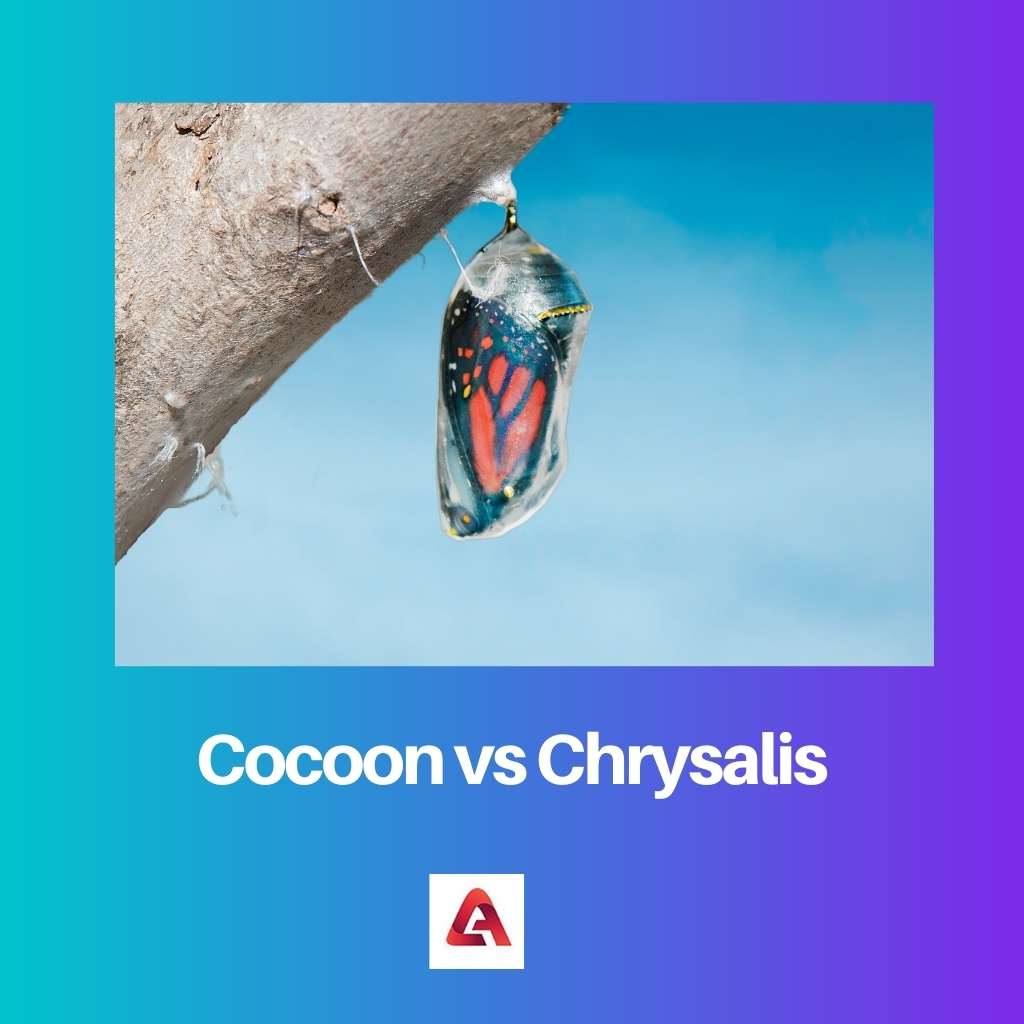Several people know that a cocoon is a construction that a caterpillar constructs across itself and arises from being transformed.
The change of a caterpillar into a moth or butterfly is one of the most amazing things to behold in nature, as one organism transforms into what appears to be an altogether different organism.
However, many people believe that chrysalis and cocoons are identical things. That’s not the case, and their meanings are significantly different.
Key Takeaways
- Cocoons are silk-wrapped protective casings created by moth larvae, while chrysalises are hard-shelled pupal cases formed by butterfly larvae.
- Cocoons are more rounded and elongated, whereas chrysalises are more streamlined and tapered.
- Both structures are essential protective environments during metamorphosis into the adult insect stage.
Cocoon vs Chrysalis
The difference between cocoon and chrysalis is that a cocoon is a type of basic nest wherein the larval forms of several animals, such as butterflies, leeches, moths, and earthworms, hatch, whereas the term chrysalis refers to the pupae of butterflies. Although the name chrysalis is used only for butterflies, not moths, an alternative term for chrysalis is the pupa.

Because moth pupae do not stiffen unlike butterfly pupae, moth caterpillars create silk cocoons over them before the last molt to shield themselves throughout this final transforming period.
This silk solidifies into a protective coating, letting the pupa undergo metamorphosis with minimal disruption.
The pupa form of the butterfly’s life span is referred to as a chrysalis. Pupa refers to a phase in the life cycle of some animals, particularly insects.
In full morphogenesis, this is a phase that occurs amid immature and mature stages. Various insects have diverse names for their pupae.
Comparison Table
| Parameter of comparison | Cocoon | Chrysalis |
|---|---|---|
| Meaning | It is a kind of primitive nest produced at the larval stage of certain animals. | It is the pupa stage of butterflies. |
| Type | Nest or protective covering | Pupa |
| Animal involved | Moths | Butterflies |
| Found | Buried in the ground or leaf litter or attached to the side of a structure. | Hanging from a structure. |
| Larva | Moth larvae build cocoons. | Butterfly larvae form chrysalis during their final transformation stage. |
What is Cocoon?
A cocoon is a casing or a type of nest made by certain insects during their larval stage, like butterflies, earthworms, moths, and turbellaria, among others. They make this cocoon to relax in while they are in the pupal phase of their life span.
Tough or delicate cocoons are possible. It can also be translucent or opaque, mesh-like or solid, multicolored, or made up of several layers. To protect their eggs, wasps create a cocoon, which is of fibrous material.
All around the fertilized eggs, worms create a mucous lime-shaped cocoon. As a result, these cocoons serve as a basic nest for the hatching of offspring.
The cocoon of certain leeches is transparent, also they remain linked to their parents until they reach maturity.
The pupae are provided with increased warmth and security from the outdoors by the cocoon. Cocoons are discovered hanging out of something, lying beneath the earth, or in leaf litter.
So when pupa reaches adulthood, they emerge from the cocoon. As a result, pupae either shred the cocoon or release enzymes to dissolve it.
Silkworm caterpillars construct cocoons solely out of silk, but other moth caterpillars combine plant materials, leaves, and sometimes even hair out of their bodies for their cocoons. Moths aren’t the sole insects who create cocoons.
Ants, worms, and spiders are just a handful of the insect species that have a pupal phase that has to be covered by a cocoon.

What is Chrysalis?
The pupal phase of butterfly evolution is the chrysalis. A butterflies caterpillar weaves a little disc of silk to anchor itself to the bottom of a leaf or branch just before its last molt.
As the pupa appears, the caterpillar drops its cover for the last time. The pupa’s exterior layer develops into a protective shell that takes on a pigment and structure to help it fit in with its environment.
The most well-known forms of pupae are chrysalises, which are showy and develop in the open.
Often these chrysalides are fastened to a surface by a Velcro-like structure of a silken pad formed by the caterpillar, settled to the bottom part of a nest, and the cremaster hook or hooks bulging from the back of the chrysalis at the edge of the pupal abdomen, by which the caterpillar repairs itself to the silken pad.
The chrysalis form of the majority of butterflies, like other forms of pupae, is characterized by limited activity. Other butterfly pupae, on the other hand, may move their abdominal sections to make noises or chase away enemies.
Development and differentiation take place within the chrysalis. By pushing hemolymph into the wing veins, the mature butterfly unfolds and stretches its wings.
While metamorphosis refers to the fast and rapid transition from pupa to imago, it refers to the entire process of changes that an insect goes through from egg to adult.

Main Differences Between Cocoon and Chrysalis
- Cocoon is a kind of primitive nest produced at the larval stage of certain animals while chrysalis is the pupa stage of butterflies.
- Cocoon is a nest or protective covering while chrysalis is the name for the pupa.
- Cocoons are involved with moths while chrysalis with butterflies.
- Cocoons are found buried in the ground or leaf litter or attached to the side of a structure while chrysalis can be found hanging from a structure.
- Moth larvae build cocoons while butterfly larvae form chrysalis during their final transformation stage.

- https://iopscience.iop.org/article/10.1088/1755-1315/939/1/012020/meta
- https://onlinelibrary.wiley.com/doi/abs/10.1002/(SICI)1098-2736(199711)34:9%3C873::AID-TEA3%3E3.0.CO;2-R
